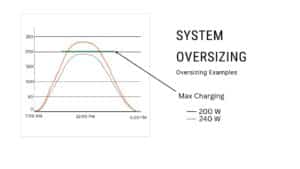About Oversizing
The term “oversizing” in the context of solar energy systems involves sizing up your Solar Array with more power than the maximum operating power of the solar inverter or MPPT controller. Why would you want to do this? Your PV array will often operate below its rated power because of the time of day or year, weather, climate, dust, pollution, and other factors. During these times, your system could produce less energy than you need. Oversizing can help you meet your daily energy consumption.
For off-grid systems, an oversized PV array gives your system more autonomy and resilience. For example, on a less sunny day, although each module produces less power, there are more of them, helping your system gather more as a whole than with an array that matches the power rating of the controller. Ideally, the additional panels not only help meet the load and charging needs for the system, but it can allow the battery to stay in a higher state of charge more of the time and recover from a low state of charge faster without a loss of load.
Depending on the location of the array and how it is mounted, the daily maximum power levels can typically be lower than the STC rated power of the solar array leaving some unused controller capacity. This is when oversizing the PV array can allow the controller to operate at full power and provide more consistent charging power throughout the day.
Morningstar MPPT Controllers can accommodate an oversized PV array that is well above the Nominal Maximum Output Power rating of the controller. This will not damage the controller. However, the controller will limit output current to 100% of the rated current output and not higher. Please note that Morningstar PWM controllers cannot be oversized and the current rating of the array should never exceed the current rating of the PWM controller.
Being able to use a larger array can provide more string sizing options. For example, if the array power with 5 solar panels is the same as the MPPT controller’s nominal power rating the only sizing options are 5 strings of 1 or 1 string of 5. This may not even meet the input voltage requirements for the controller. Being able to oversize the array with 6 panels makes it possible to use 3 strings of 2 or 2 strings of 3 and perfectly match the desired input voltage for the array.
The alternative to oversizing the PV array would be to use a higher power controller or an additional controller at a higher cost and possibly additional wiring.
Morningstar’s MPPT controllers support oversizing up to 200% over the controller’s Maximum Nominal Output Power rating. However, it is not a general practice to design systems with an array size of more than 25-35% of the power rating of the controller.
The Morningstar String Calculator provides PV array sizing results for MPPT controllers that include the following oversized PV array information.
MPPT Power Indications

Significant Oversizing (>30% above Max. Nominal Solar Power) for this configuration.
Visualizing the difference
SS-MPPT 15L (240W vs. 200W module) on a Clear Day

This graph illustrates the output power levels of a SunSaver MPPT controller—comparing a 200W module to a 240W module—operating on a clear & sunny day with a potential peak input array power equal to the STC maximum power (Pmp). The output power is slightly less than the input power due to the controller’s efficiency. For a 200 W module, the max output power of the controller will remain below the max nominal output power rating of the controller. However, the 240 W PV Module exceeds that 200 W limit. With the 240 W Module, although you do lose the excess energy above 200W due to the solar controller capping, throughout the day, you have significant gains compared to the 200W PV module. The 240 W panel gathers more energy than the 200 W in the morning and afternoon when there is less solar energy available. This extra energy is pictured as the space between the 200W and the 240W Curve and below the max charging limit.
The daily peak array power and maximum output power of the SunSaver controller for a system using these modules will vary greatly on a daily basis.
Some Drawbacks of Oversizing
With research, you’d find some drawbacks to battery oversizing. Is oversizing right for you?
- Because you are producing more energy than the system can manage, additional energy is “clipped” and is unused. Solar energy is not as expensive in today’s market, so this is less of a concern.
- Selecting a charge controller that allows the required amount of oversizing (most tolerate 200%) is integral to an effective system, and selecting the wrong devices could result in a shortened lifespan or lessened efficacy.
- Your system setup and wiring become more complicated.
- Initial system costs would be higher because of the additional PV Modules. Although PV modules have become cheaper in recent years, this could still be a factor.
Many of the drawbacks of oversizing have been reduced in today’s market, including the cost of “clipped” energy and PV Modules. If you are in a climate with varying solar energy throughout the year, or excessive heat, oversizing could significantly improve your solar energy system’s performance. Oversizing is becoming a more popular solution because the price of solar panels and solar energy is lower than in the past. Because of the lower cost, you can produce more energy using your solar panels without losing a fortune in excess energy.
Oversizing Applications
The overall cost of the system is an important consideration when designing off-grid PV systems and oversizing the PV array with MPPT controllers can often cut costs significantly without affecting the performance of the system. We receive support requests for help with array sizing for a particular PV module and solar controller. With the option to oversize the array, it often means the customer can use the controller and module they want to use with very good results.
One example of an application where oversizing can make a big difference would be if you want to use a PS-MPPT-40 for a lighting system but the array power needs to be higher than the nominal power rating of the controller. Rather than purchasing an additional controller or finding a larger controller that also includes lighting control–which can be a challenge–oversizing the array with the PS-MPPT-40 is the optimal solution.
For larger systems that require several controllers, using fewer MPPT controllers with larger PV arrays not only saves on the controller cost but also on the cost of wiring and balance of system (BOS) components. In addition, it will reduce the installation time and take up less wall space or space inside an enclosure.
Having the option to oversize the array provides the opportunity to size the PV array larger than it was originally intended to be or increase the size of the PV array at a later date if needed, without having to purchase and install additional solar controllers. Oversizing the array like this gives your system more consistency and reliability. Consistent and reliable energy is key for a variety of applications.
Perhaps you use your solar energy system for a security or communications system that you need functioning at all times. Maybe you are designing a system for an off-grid home or rural electrification project that includes generator backup and want to reduce the runtime of the generator. Maybe it is for a warehouse or barn, prioritizing a reduced energy bill or consistent power in a remote location. No matter your target results, one of the primary keys to achieving them is consistent, reliable energy production. No one can control the sun, but with a larger PV array, your solar energy system can do more to maintain your basic energy needs.
More consistent solar energy throughout the day helps maintain battery health by preventing consistent and deep battery drainage, which can negatively impact the battery lifecycle. Additionally, your MPPT Charge Controller operates at maximum power rating, getting to its full charging potential more often. Another factor that helps with system energy consistency is battery size. Oversizing, with the right battery size for your needs, creates system autonomy, capable of being your sole energy source even with little to no sunlight that day.
Conclusion
With Morningstar’s MPPT controller oversizing capabilities, you have the flexibility to get more from the solar controller, have more solar array sizing options and save money on solar controllers and BOS costs. The additional energy production from an oversized PV array can provide more consistent energy production with more energy when it is most needed, when there is less solar energy available; on cloudy days, earlier and later in the day, and times of the year when there is less direct sunlight.
Overall, oversizing should be considered as a viable, cost-cutting solution that can also enhance solar energy system performance and ensure a consistent power supply.
For more information about PV Array oversizing with MPPT controllers, see Morningstar’s TrakStar™ MPPT Technology & Maximum Input Power technical document.

